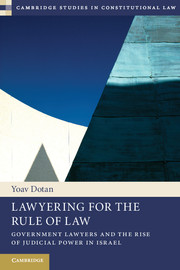Book contents
- Frontmatter
- Dedication
- Contents
- Acknowledgments
- List of figures
- List of tables
- Introduction The government’s lawyer
- 1 The Israeli legal system and the rise of judicial activism in the High Court of Justice
- 2 The High Court of Justice Department (HCJD): overview and history
- 3 Litigating for the government
- 4 The dilemma of serving two masters
- 5 Sorting things out: government lawyers in transformative litigation
- 6 The government lawyer as adjudicator: “pre-petitions” and the HCJD
- Conclusion
- Table of Cases
- Bibliography
- Index
1 - The Israeli legal system and the rise of judicial activism in the High Court of Justice
Published online by Cambridge University Press: 05 June 2014
- Frontmatter
- Dedication
- Contents
- Acknowledgments
- List of figures
- List of tables
- Introduction The government’s lawyer
- 1 The Israeli legal system and the rise of judicial activism in the High Court of Justice
- 2 The High Court of Justice Department (HCJD): overview and history
- 3 Litigating for the government
- 4 The dilemma of serving two masters
- 5 Sorting things out: government lawyers in transformative litigation
- 6 The government lawyer as adjudicator: “pre-petitions” and the HCJD
- Conclusion
- Table of Cases
- Bibliography
- Index
Summary
General elements of the Israeli legal system
Israel’s “half baked” constitution
In many countries around the world the word “constitution” means a single formal document that was officially and solemnly ratified through an extraordinary procedure at one stage of history, and which contains most of the fundamental institutional arrangements of the government system including a bill of rights. If this is the meaning of the word constitution, then Israel is one of the very few nations that at the beginning of the twenty-first century is yet to have one. Indeed, at the Declaration of Independence of Israel (which was solemnly introduced to the people of the State on the date of Establishment on May 15, 1948), the founders of the State provided that the people of Israel would elect a “Constituting Assembly” that would form a constitution for Israel. After the Assembly was elected, however, it soon decided to turn its name into the First Knesset (i.e. Parliament), and to postpone the preparation of the constitution for a later stage. Later on, a decision was taken by the Knesset – in the famous Harrari Resolution of 1950 – to postpone the adoption of a constitution as one document, and instead to prepare it piecemeal – chapter by chapter – in a series of basic laws to be enacted by future Knessets, which would eventually be brought together to form the constitution.
- Type
- Chapter
- Information
- Lawyering for the Rule of LawGovernment Lawyers and the Rise of Judicial Power in Israel, pp. 14 - 50Publisher: Cambridge University PressPrint publication year: 2013

